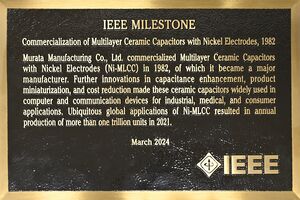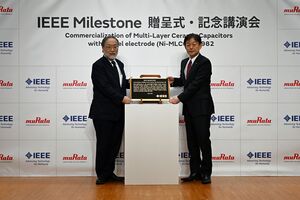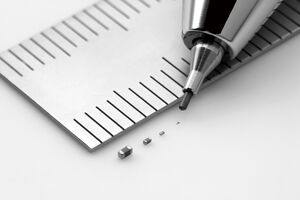Milestones:Commercialization of Multilayer Ceramic Capacitors with Nickel Electrodes, 1982
Title
Commercialization of Multilayer Ceramic Capacitors with Nickel Electrodes, 1982
Citation
Murata Manufacturing Co., Ltd. commercialized Multilayer Ceramic Capacitors with Nickel Electrodes (Ni-MLCC) in 1982, of which it became a major manufacturer. Further innovations in capacitance enhancement, product miniaturization, and cost reduction made these ceramic capacitors widely used in computer and communication devices for industrial, medical, and consumer applications. Ubiquitous global applications of Ni- MLCC resulted in annual production of more than one trillion units in 2021.
Street address(es) and GPS coordinates of the Milestone Plaque Sites
1-10-1 Higashikotari, Nagaokakyo-shi, Kyoto, 617-8555 JAPAN, (GPS: 34.923900, 135.701899)
Details of the physical location of the plaque
In the ground floor lobby of the Murata Manufacturing Co. headquarters building is a Special Exhibition Area that includes a table displaying the Milestone plaque with important company products and awards.
How the plaque site is protected/secured
The ground floor lobby has 24-hour security staff. From 8:30am-5pm on weekdays, visitors should visit the Reception Desk and ask to see the Special Exhibition Area.
Historical significance of the work
The historical significance of Murata’s commercialization of Ni-MLCCs is briefed as follows.
1. Historical background of Murata’s commercialization of Ni-MLCCs:
Presently, multilayer ceramic capacitors (MLCCs) are made of alternating layers of dielectric ceramics and metallic inner electrodes, whose capacitance density, together with those of the traditional monolayer disc/tube-type ceramic capacitors, has been changing as shown in Fig. 1. The annual worldwide production of MLCCs has reached the level of 3 trillion, most of which are produced with base metal electrodes (cf. mainly made of Ni [nickel]), because in comparison with the conventional noble metal electrodes (cf. mainly made of Pt [platinum], Pd [palladium], or Ag[silver]-Pd [i.e. Ag70Pd30 alloy]) cost savings can be greatly obtained, using much cheaper base metal electrodes in MLCCs [1, 2]. Recently the worldwide share of Murata’s Ni-MLCCs has reached 43%.
Historically, in addition to the discovery of the barium titanate (BaTiO3) ceramics in the middle 1940s, the progress of the surface mount technology triggered the development of a series of MLCCs in the late 1960s through the early 1970s. At this early stage the electrodes of MLCCs were made of noble metals, such as Pt, Pd, Ag-Pd, etc., since when heated in air they were hard to be oxidized and hence did not lose their electrical conductivities. Although the MLCCs with Ag-Pd electrodes were the cheapest of all MLCCs, the material prices of both Ag and Pd were skyrocketing due to the 1973 oil crisis, and hence it became evident that the utilization of much cheaper base metals of Ni for the electrodes would greatly reduce the production expenses of MLCCs.
However, there was a big drawback in using Ni for the electrodes, such that when co-fired with the dielectrics in air the Ni electrodes were oxidized and lost their electrical conductivity. Thus, in 1974 Murata intended to seek a solution for developing new dielectrics to compose MLCCs with Ni electrodes [3].
2. Development of new MLCCs with BaTiO3-based dielectrics and Ni electrodes:
The remarkable progress of the surface mount technology accelerated the industrial demands for MLCCs with Ag-Pd electrodes in the early 1970s, for which the material pricess of both Ag and Pd soared sharply due to the 1973 oil crisis. Thus, in 1974 Murata focused on a cheaper base metals of Ni in substitution for the Ag-Pd electrode, and started the search for dielectrics to compose MLCCs with Ni electrodes. A major problem of using Ni for the electrodes was that the MLCCs had to be sintered in reducing atmospheres to protect Ni from oxidation. Although efforts to accomplish this substitution of Ni for Ag-Pd had been made for years, the first successful realization of the MLCCs with Ni electrodes at significant production rates was achieved by Murata in the early 1980s [2]. Specifically, it was found that the use of Ca-doped, BaTiO3-based dielectrics allowed the MLCCs to be sintered in reducing atmospheres compatible with Ni electrodes [2, 3, 4]. Confirming that the new dielectrics exhibited their excellent insulating property even if co-fired with Ni electrodes, in 1982 Murata embarked on the mass production of the new MLCCs with BaTiO3-based dielectrics and Ni electrodes, usually abbreviated to Ni-MLCCs [3].
3. Achievements of the commercialization of new Ni-MLCCs:
Owing to the progress of both the surface mount technology and the miniaturization technology, in 1974 Murata initiated a diligent effort to reduce the dielectric/electrode thickness as well as to augment the number of layers, therefore the capacitance density, of Ni-MLCCs, and eventually achieved the quality improvement of Ni-MLCCs, as can be seen from Fig. 2. Thus, the industrial demands for these Ni-MLCCs grew so drastically that Murata attained the lead in the commercialization of Ni-MLCCs. Thanks to Murata’s outstanding achievements of developing the new Ni-MLCCs, Dr. Yukio Sakabe at Murata won the Fulrath Award from the American Ceramic Association in 1986, and Murata also received the Corporate Technical Achievement Award at the American Ceramic Association’s 100th Annual Meeting in 1998 [5].
Obstacles (technical, political, geographic) that needed to be overcome
1. Obstacle to enhancing the capacitance density of Ni-MLCCs:
The oil crisis in 1973 raised the prices of noble metals used for electrodes of MLCCs so radically that Murata had to seek a substitute for the electrodes. Murata soon focused on a much cheaper base metal of Ni to be used for the electrodes. Through persistent efforts spent for years, in the early 1980s Murata managed to find new Ca-doped, BaTiO3-based dielectrics to compose MLCCs with Ni electrodes [2], which gave birth to longed-for Ni-MLCCs. Through repeated attempts to improve their capacitance characteristics, Murata succeeded in enhancing the capacitance density of Ni-MLCCs as shown in Fig. 2. Eventually, in 1982 Murata could embark on the mass production of the new Ni-MLCCs,
2. Obstacle to maintaining the reliability:
The first years of the industrialization of base metal electrodes were characterized by a severe quality crisis. In 1979 the US company Centralab (Milwaukee, USA) launched the manufacture of MLCCs with base metal electrodes, based on Mn[manganese]-acceptor doped (Ba,Ca)(Ti,Zr)O3. Production and sale of these MLCCs had to be stopped rather soon, due to disastrous degradation of the insulation resistance [1]. Motivated by this accident, Murata dedicated immense energy to developing more reliable MLCCs with base metal electrodes. Murata first focused on a base metal of Ni, and concentrated on developing MLCCs with Ni electrodes. Through vigorous efforts dedicated for years, Murata succeeded in developing the new MLCCs, whose BaTiO3-based dielectrics exhibited their excellent insulating property even if co-fired with Ni electrodes. Eventually, Murata’s new Ni-MLCCs could maintain all specific qualities over a validity period.
Features that set this work apart from similar achievements
There are a number of distinctive features of Murata’s Ni-MLCCs as summarized below.
1. Distinctive properties of the new Ni-MLCCs:
Through persistent efforts to reduce the dielectric/electrode thickness as well as to enhance the capacitance density, Murata greatly improved the qualities of Ni-MLCCs as shown in Fig. 2 (e.g. the present capacitor sizes are ranging between 0.25x0.125x0.125 [mm] and 5.7x5.0x5.0 [mm]). Moreover, considering that the material price of Ni became less than 1/1000 of that of Ag-Pd in 2019, it can be seen that Murata has greatly contributed not only to enhancing the capacitance density but also to reducing the production expenses of Ni-MLCCs.
2. Contribution to the miniaturization of electronic components:
Owing to consistent efforts to enhance the capacitance density as well as to save the production expenses, as stated above, Murata expanded the applicability of Ni-MLCCs extensively to industrial/medical use as well as deeply to commercial use, such as for home appliances, PCs, cameras, internet devices, mobile terminals, wearable devices, etc. Furthermore, noting that more than 1000 Ni-MLCCs have been incorporated even in a tiny smart phone, it may be safely acknowledged that Murata’s Ni-MLCCs have greatly contributed not only to the saving of fabrication expenses but also to the miniaturization of a great number of electronics components.
3. Contribution to the growth of industrial demands:
In 1979 the US company Centralab launched the manufacture of MLCCs with base metal electrodes, which caused a serious accident of disastrous degradation in the insulation resistance, resulting in the production stoppage [1]. In contrast with this company, Murata initiated a massive effort to carry out the project of developing new MLCCs with Ni electrodes, i.e. Ni-MLCCs, in which not only the reduction of the dielectric/electrode thickness but also the enhancement of the capacitance density was pursued to the full extent possible, as can be seen from Fig. 2. Thus, the industrial demands for these Ni-MLCCs grew to such an extent that an immense amount of Murata’s new Ni-MLCCs were embedded vastly in every possible variety of electronics components, until Murata has acquired the global lead in the commercializaation of Ni-MLCCs [5].
Significant references
References
[1] D.F.K. Hennings, “Multilayer ceramic capacitors with base metal electrodes”, in Proc. IEEE International Symp. on Applications of Ferroelectrics, pp. 135-138, 2000.
[2] D.M. Smith, “Multilayer ceramic capacitors with base metal electrodes”, in Proc. IEEE International Symp. on Applications of Ferroelectrics, pp. 369-373, 2000.
[3] Y. Sakabe, “Nickel electrode ceramic capacitors”, Electronic Ceramics, vol. 18, pp. 37-42, 1987 (in Japanese).
[4] Y. Sakabe and H. Seno, “Method for making monolithic ceramic capacitor employing non-reducing dielectric ceramic composition”, U.S. Patent 4,115,493, September 19, 1978.
[5] Y. Sakabe, “Development of the multilayer ceramic capacitors with base metal electrodes”, Abstract Book, the American Ceramic Association Society’s 100th Annual Meeting & Exposition, vol. 43, 1998.
Appendix
Reference [3] was written in Japanese, for which English summaries are briefed as follows:
Considering that as compared with the material prices of Pd and Ag-Pd electrodes of MLCCs, that of Ni electrode was almost 1/700 and 1/300, respectively, in the late 1970s, Murata was firmly convinced that MLCCs with Ni electrodes would extremely reduce the fabrication expenses of MLCCs. After persistent efforts had been made for years to develop new BaTiO3-based dielectrics to be co-fired with Ni electrodes, eventually in 1982 Murata succeeded in embarking on the mass production of the new MLCCs with Ni electrodes.



